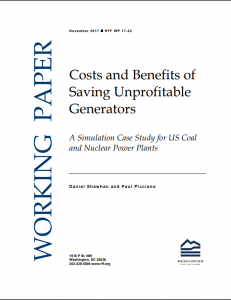Full Title: Costs and Benefits of Saving Unprofitable Generators
Author(s): Daniel Shawhan and Paul Picciano
Publisher(s): Resources For the Future
Publication Date: November 1, 2017
Full Text: Download Resource
Description (excerpt):
In this paper, we use a detailed power sector model, E4ST, to project effects of preventing a set of unprofitable generators from retiring. We simulate the “Grid Resiliency Pricing Rule” proposed by the US Department of Energy in the fall of 2017, and several variations. In the proposed policy, eligible coal and nuclear generators would be guaranteed revenues sufficient to make them profitable. Our analysis is an examination of that potential policy and an illustrative case study for similar national, regional, or state policies in the United States or elsewhere. The results highlight the importance of estimating environmental net benefits, as they dominate the cost–benefit analysis of all of the policy variations considered. In the simulation results, the total subsidy amount required to guarantee profits for coal and nuclear generators in 2025 is $7.6 billion. If the policy is in effect from 2020 through 2045, it prevents the retirement of approximately 25 GW of coal-fueled capacity, delays the retirement of 20 GW of nuclear capacity, causes 27,000 premature deaths in the United States, and has an estimated total net cost of $263 billion during those 25 years. Of that, $217 billion is environmental damages and $45 billion is nonenvironmental net costs. We find that the policy’s net non-environmental cost for electricity end-users is $72 billion and its net benefit for generation owners is $28 billion. In an alternative scenario, we find that guaranteeing only recovery of costs necessary for continued operation, instead of guaranteeing profits, shifts costs from end-users to generators enough to nullify the policy’s effect on electric bills and make it detrimental to generator profits, but has little effect on the other outcomes. Preventing the retirement of just nuclear capacity is the only simulated policy that produces positive net benefits. Our analysis assumes that the policies do not otherwise affect the efficiency of the electricity markets, and it does not estimate effects on reliability or resilience, but it could be considered in combination with analyses of such effects.
